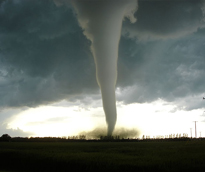
Contact our PIO directly to share health news.

770.339.4260
Tornado Safety

A Tornado is the Worst.
Tornadoes are nature’s most violent storms. Spawned from powerful thunderstorms, tornadoes can cause fatalities and devastate a neighborhood in seconds. A tornado appears as a rotating, funnel-shaped cloud that extends from a thunderstorm to the ground with whirling winds that can reach 300 miles per hour. Damage paths can be in excess of one mile wide and 50 miles long.
Some tornadoes are clearly visible, while rain or nearby low-hanging clouds obscure others. Occasionally, tornadoes develop so rapidly that little, if any, advance warning is possible. Before a tornado hits, the wind may die down and the air may become very still. A cloud of debris can mark the location of a tornado even if a funnel is not visible. Tornadoes generally occur near the trailing edge of a thunderstorm.
Know Your Alerts
Tornado Watch means conditions are favorable for tornadoes to develop, but there is not an imminent threat.
Tornado Warning means a tornado has been detected and an imminent threat to life and property has developed.
Monitor area forecasts to know if threatening weather is possible and track storms by listening to weather radio, local TV or radio reports.
Take Immediate Action
If a tornado is imminent and you are in a home or building, move to a pre-designated safe room on the lowest floor, such as a basement. If you don’t have a basement, move to a small interior room, closet, bathroom or hallway – and get under a sturdy piece of furniture. Remember to always put as many walls as possible between you and the outside.
Do not open windows, and avoid taking shelter near windows.
If in a vehicle, stay buckled in your seat and try to drive to the closest sturdy shelter. If debris starts flying while you are driving, pull over and park. Two options are available: Stay in the car with the seat belt on. Put your head down below the windows, covering with your hands and a blanket if possible. Or – if you can safely get noticeably lower than the level of the roadway – exit your car and lie in that area, covering your head with your hands.
Because mobile homes are not safe during tornadoes, abandon your mobile home to seek shelter in a sturdy building immediately.
For more information on tornado safety, visit:
Contact our PIO directly to share health news.


